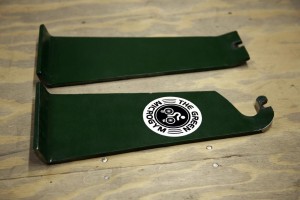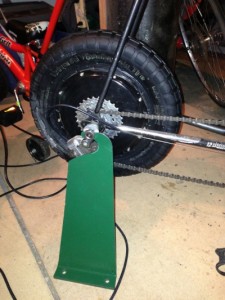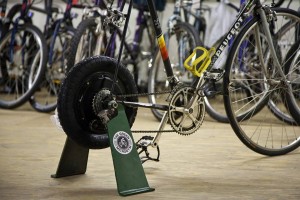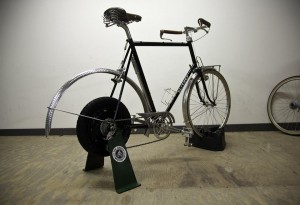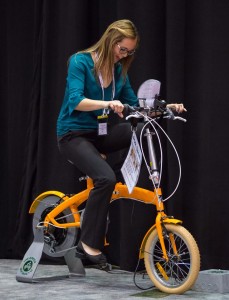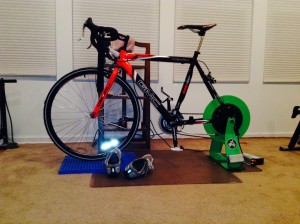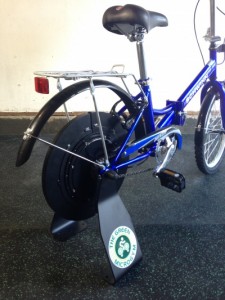The UpCycle Ecocharger DIY kit has been used all over the world to harness human power!
This is the story of how it went from a crude prototype…
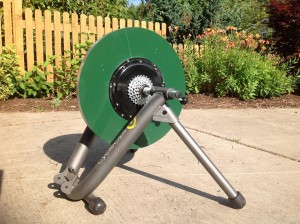
The very first hub motor flywheel bike trainer idea
To the best pedal generator kit in the world, helping Chevrolet power the 2015 Toronto Pan Am Games!
Necessity is the Mother of Invention
It started with a phone call from the New York City Mayor’s office a week after Hurricane Sandy.
They were frantically looking for any possible solution to getting electricity to the people who had been powerless for several days.
At that point, I only had electricity generating gym equipment, and no way to get such heavy machines shipped across the country.
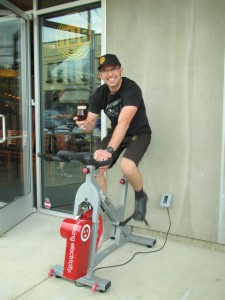
The original Grid Tied Spin Bike Retrofit
But it gave me the inspiration to flesh out an idea that might work for the home.
A New Twist
The idea of using an electric bike hub motor as a generator was not new to us. We had been working on that for awhile, but always with the idea of using it as part of an indoor cycle at a gym.
I knew a device for the home would have to be more simple (no electrical engineers and no custom software!), and probably would sell best as an affordable DIY kit instead of a fully assembled, out of the box solution. So, I started trying to figure out how it would go together. My first shot was using a bike trainer stand with a wooden flywheel.
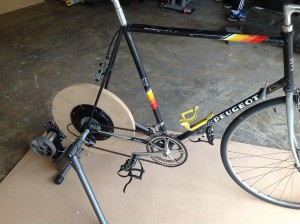
The first UpCycle Ecocharger connected to my 10 speed bike
It worked, but not very well. The wooden flywheel was hard to install and way too light to do any good. A heavy flywheel was necessary to add inertia, so that when the resistance kicked in, it would feel like a smooth ride and reduce the herky-jerky feeling of all other bicycle generators ever created (I knew because I had tried most of them).
The bike stand also kept breaking because it wasn’t heavy duty enough. They aren’t made to handle that type of axle, and since the back tire wasn’t resting on the roller (used to create resistance for a normal bike trainer), it was not very stable.
Unexpected Inspiration
One day, someone shared an article on facebook about a prison in Brazil that – inspired by The Green Microgym – was using pedal power to charge batteries that could light up some dark areas of town, and also help inmates reduce their sentence through exercise. It sounded like a pretty crazy idea, but the picture of the setup they used got me thinking about a heavy duty, but very simple bike stand.
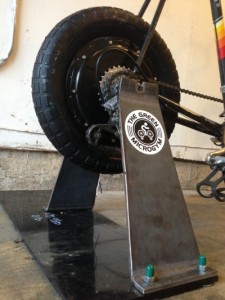
First UpCycle Ecocharger stand pieces
I made a simple drawing and brought it to a local machine shop for a rough prototype. I also started experimenting with putting a wheelbarrow tire on the generator and filling it with sand. This worked to create inertia, but there was one big problem. Sand everywhere! No matter how much I sealed, a few grains would always find a way out. It was a mess.
Starting to Come Together
The stand pieces worked great though. They were strong and stable. But it wasn’t done yet. I needed to figure out how to bring the right side stand out far enough that the derailleur could move freely, shifting through all the gears.
First, I tried cutting out a part of the stand to make room. That worked for some bikes, but not others.
After a lot of experimenting, I finally found the solution I still use to this day.
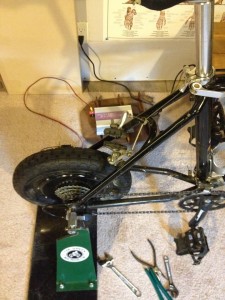
UpCycle Ecocharger with coupling nut axle extension
Using a coupling nut from the hardware store, I re-thread it on one side so it can connect both to the axle of the generator, but also to a standard 14mm bolt. This may seem a bit over the top, but I have yet to find a simpler, more reliable solution. I could certainly have a custom coupler created, but it would be very expensive.
Minimally Viable? Yes. Good enough? No
I had to figure out how to get a heavy flywheel made, for a decent price, that was easy to install.
I worked with Jeff Struble who helped polish up the design of the stand pieces, and he led me to a great machine shop, Bridge City Steel in Portland and an owner, Chris Gaylord, who helped me create a steel version of the heavy flywheel I needed.
Once this was done, I felt comfortable selling the Ecocharger, making sure everybody knew it was a DIY Kit.
Finishing Touches
I thought I was almost done! Those are famous last words for product development. I did, however, have a viable product. I combined it with a small scale grid tie inverter and watt meter, and could easily create between 75 and 125 watts of continuous electricity that plugged into a normal wall outlet and helped power the building. It was also a great workout – very similar to a ride on a spin bike, except you change gears to change resistance.
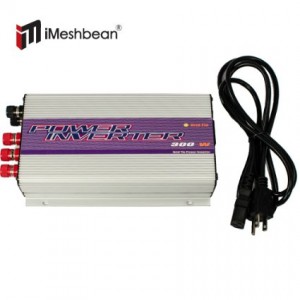

More Than Just a DIY Kit
In early 2015, I had the great fortune to work with Glencoe Elementary and Chevrolet to continue to improve the UpCycle Ecocharger.
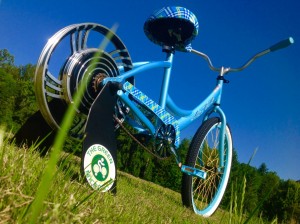
The Ecocharger for the Schools combines a 300 watt grid tie inverter with a rotating police light on a kid’s single speed cruiser bike to help active learners get the wiggles out, power the building, and learn the value of a watt.
Working with engineers at Chevrolet while they created an exhibit for the 2015 Pan Am Games, we used their expertise and extensive testing protocols to find upgraged electronics. The UpCycle Ecocharger DIY kit can now be hooked up to a 600 watt grid tie inverter, enabling even the most powerful cyclists help power their home on a smooth, durable bike trainer tested under extreme conditions.
Constant and Never Ending Improvements
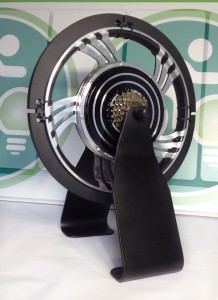
The flywheel is now lighter and easier to install, with a generator that looks a lot cooler too!
Future planned improvements as of this writing:
Off Grid: A charge controller to enable easy, safe, reliable charging of 12,24, and 36 volt batteries, so you can use the UpCycle Ecocharger completely off the grid.
Multiple Uses: An electric cruiser bike that you can put on a stand and use to make electricity at home, so you can have a nice pedal assist on your rides, and make electricity on rainy days from the comfort of your living room.

